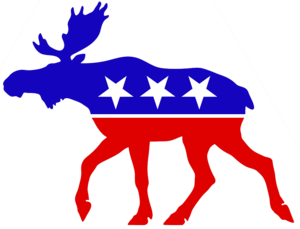Progressive Party (United Commonwealth): Difference between revisions
Potatoduck (talk | contribs) No edit summary |
Potatoduck (talk | contribs) No edit summary |
||
| Line 44: | Line 44: | ||
| merger = | | merger = | ||
| split = | | split = | ||
| predecessor = Social Democratic Party USA | | predecessor = Democratic Party (Factions) | ||
Social Democratic Party USA | |||
Progressive Party (1948–1955) | Progressive Party (1948–1955) | ||
Revision as of 19:18, 4 May 2024
Progressive Party | |
|---|---|
 | |
| Founded | March 18th, 1981 |
| Preceded by | Democratic Party (Factions)
Social Democratic Party USA Progressive Party (1948–1955) |
| Headquarters | Boston, Massachusetts |
| Youth wing | Youth Progressive Federation |
| Ideology | Majority: Progressivism, Social Democracy, Anti-Communism Factions: Rooseveltism[1], Republicanism, American Patriotism |
| Political position | Center-left to Left Wing |
| Continental affiliation | Pan-American Progressive Federation |
| International affiliation | Socialist International |
 | |
The Progressive Party is one of several Major Political Parties in the United Commonwealth of America. Formed in 1980, mainly by more left-wing Democrats and some members of the Social Democratic Party, it joined the "Lincoln Coalition" formed by the Democratic and Republican parties in February 1980. The Party's combination of social democratic principles and American iconography is often credited with helping the coalition win the 1982 election. Despite having more socialist internal factions, the party maintains an anti-communist[2] ideology much like the former Social Democratic Party USA.
History
Background
In the aftermath of the collapse of the United States, surges of left-wing sentiments rose across the former union, resulting in the formation of various blocs vying for power. In the United Commonwealth, initial skirmishes between the Communist Party USA[3] and the newly formed government saw the banning of the party, resulting in Communists forming the Socialist Party with more moderate socialists in an attempt to follow the 'Popular Front' model. This less outwardly communist but still pro-soviet party made gains in polling in late 1981, joining the Democratic Socialist Party UCA to form an electoral coalition for the upcoming 1982 election. After fears of a Socialist success, many in the Democratic and Republican parties eventually agreed to a temporary coalition, but still fearing a loss, many more left-wing Democrats and members of the former Social Democratic Party and (then) current SDPUCA formed the Progressive Party in march of 1981, negotiating entry into the Union Preservation Alliance.
After the election
After a UPA victory in the 1982 election, many more hardline socialists would begin to fall out of favor, and by the large UPA successes of the 1984 congressional elections and the 1986 presidential election, the Socialist front would collapse, and before the 1990 election, the UPA would dissolve, with the Progressive Party emerging as one of the largest parties in the nation.
Mergers with other parties
By 1990, the Social Democratic Party UCA had mended its rift, only to split once again at the formation of the Commonwealth Socialist Party, a much more moderate merger of the Socialist Party UCA and DSUCA, with a majority of the Social Democrats joining the Progressive Party.